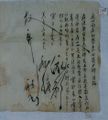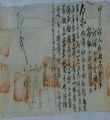"(Translation) 海南尹氏 土地買賣 立案"의 두 판 사이의 차이
Ewa Rzanna (토론 | 기여) (새 문서: {{Primary Source Document3 |Image = |English = |Chinese = |Korean = ('' '') |Genre = [[ ]] |Type = |Author = |Year = |Key Concepts= |Translator = 2018 Summer Hanmun Workshop...) |
Sanghoon Na (토론 | 기여) 잔글 |
||
| (사용자 2명의 중간 판 48개는 보이지 않습니다) | |||
| 1번째 줄: | 1번째 줄: | ||
{{Primary Source Document3 | {{Primary Source Document3 | ||
| − | |Image = | + | |Image = 1682호비월매토지매매명문등.jpg |
| − | |English = | + | |English = Estate Certificate by Haenam Prefecture |
| − | |Chinese = | + | |Chinese = [http://archive.aks.ac.kr/imageViewer/ImageViewer.aspx?datauci=G002+AKS+KSM-XD.1683.4682-20101008.B003a_003_00409_001&refuci=G002+AKS+KSM-XD.1683.0000-20101008.B003a_003_00409_003&fname=G002+AKS+KSM-XD.1683.4682-20101008.B003a_003_00409_001-IMG.001.jpg&closed=true 海南尹氏 土地買賣 立案] |
| − | |Korean = ( | + | |Korean = 해남윤씨 토지매매입안(Haenam Yunssi Tojimaemae Iban) |
| − | |Genre = [[ ]] | + | |Genre = [[Historical Manuscripts]] |
| − | |Type = | + | |Type = Certificate |
| − | |Author = | + | |Author = Tami |
| − | |Year = | + | |Year = 1683 |
| − | |Key Concepts= | + | |Key Concepts= bill of sale, petition, certificate, chief slave |
|Translator = [[2018 Summer Hanmun Workshop (Advanced)#Participants | Participants of 2018 Summer Hanmun Workshop (Advanced Translation Group)]] | |Translator = [[2018 Summer Hanmun Workshop (Advanced)#Participants | Participants of 2018 Summer Hanmun Workshop (Advanced Translation Group)]] | ||
| − | |Editor = | + | |Editor = Sanghoon Na |
|Translation Year = 2018 | |Translation Year = 2018 | ||
| 16번째 줄: | 16번째 줄: | ||
[[File:Backward.png|right|40px|link=2018 Summer Hanmun Workshop (Advanced)#Primary Sources for Korean Studies]] | [[File:Backward.png|right|40px|link=2018 Summer Hanmun Workshop (Advanced)#Primary Sources for Korean Studies]] | ||
<gallery> | <gallery> | ||
| − | 파일:.jpg| | + | 파일:1683해남현입지.jpg |link=(Translation) 海南尹氏 土地買賣 立案|III-6-1. 1683年 海南縣 立旨 해남현 입지('' Haenamhyeon Ipji'') |
| + | 파일:1682호비월매토지매매명문.jpg |link=(Translation) 海南尹氏 土地買賣 立案|III-6-2. 1682年 戶婢 月梅 土地賣買明文 호비 월매 토지매매명문(''Toji-maemae-myeongmun'') | ||
| + | 파일:1683사노담이초사.jpg |link=(Translation) 海南尹氏 土地買賣 立案|III-6-3. 1683년 私奴 淡伊 招辭 사노 담이 초사(''Sano Dami Chosa'') | ||
| + | 파일:1683사노석벽초사.jpg |link=(Translation) 海南尹氏 土地買賣 立案|III-6-4. 1683년 私奴 石碧 招辭 사노 석벽 초사(''Sano Seokbyeong Chosa'') | ||
| + | 파일:1683호비월매입안.jpg |link=(Translation) 海南尹氏 土地買賣 立案|III-6-5. 1683年 戶婢 月梅 立案 호비 월매 입안(''Hobi Wolmae Iban'') | ||
</gallery> | </gallery> | ||
=='''Introduction'''== | =='''Introduction'''== | ||
| + | |||
| + | 1683년 해남현(海南縣) 입지(立旨) | ||
| + | |||
| + | |||
| + | http://archive.aks.ac.kr/Inspection/insDirView.aspx?dataUCI=G002+AKS+KSM-XD.1683.4682-20101008.B003a_003_00409_001 | ||
| + | |||
| + | |||
| + | 1682년(肅宗8)에 私奴 淡伊가 幼學 李必晟의 戶婢 月梅에게 畓 9마지기를 放賣하면서 작성한 明文. | ||
| + | |||
| + | |||
| + | 주제 | ||
| + | 1682년(肅宗8)에 사노 담이가 畓 3마지기를 유학 이필성의 호비 월매에게 正租 10石을 받고 팔면서 써준 明文이다. 正租는 벼를 말한다. 매매 대상인 토지는 花山一道面 大路越員에 있는 若字 畓 3마지기인데, 이는 세 배미[夜味]로 이루어진 9마지기의 일부분으로서, 東邊의 한 배미이며, 卜數로는 10卜 3束이다. 배미[夜味]는 하나의 논두렁으로 구획된 畓 한 개를 헤아릴 때 쓰는 말이다. 따라서 이는 면적의 광협과는 상관이 없는 말이다. 員은 전답이 소재하는 들판을 이른다. 이 명문의 작성에는 畓主 이외에, 證人으로는 사노 石碧이, 證人 및 保人으로는 內奴 處日이, 筆執으로는 진득창이 각각 참여하였다. 內奴는 內需司에 소속된 종이다. 이 명문에는 증인, 보인, 필집이 각각 이 매매의 내용이 진실함을 진술한 招辭가 붙어 있으며, 官에서는 이를 기초로 이듬해인 1683년(肅宗9)에 이 매매 사실을 확인해주는 立案을 발급하였다. | ||
| + | |||
| + | |||
| + | 용어 | ||
| + | 마지기(斗落只)는 파종량을 기준으로 한 전답의 면적 단위이다. 1마지기는 한 말[斗]의 씨앗을 파종할 수 있는 면적인데, 대개 토질에 따라 그 면적의 크기에 다소 차이가 있다. 卜數는 소출량에 근거한 租稅 單位이며, 負數로도 쓴다. 1負는 타작하기 전의 볏단 한 짐의 분량이다. | ||
=='''Original Script'''== | =='''Original Script'''== | ||
| − | {|class="wikitable" style="width: | + | {|class="wikitable" style="width:100%; background-color:#ffffff;" |
| − | !style="width: | + | !style="width:25%;"|Image || style="width:25%;"|Text || style="width:50%;"| Translation |
|- | |- | ||
| − | | | + | | [[File:1683해남현입지.jpg |border|1683해남현입지|400px]] |
| + | || | ||
| + | 花山面居幼學李必晟戶婢月梅 | ||
| + | |||
| + | 右謹陳所志矣段婢矣上典主敎是縣居私奴 | ||
| + | |||
| + | 淡伊處花山一道大路越員若字畓參斗 | ||
| + | |||
| + | 落只庫乙上年分買得未及官斜爲白有等 | ||
| + | |||
| + | 以敢此呼訴爲白去乎依例斜給行下爲白只爲 | ||
| + | |||
| + | 行下向敎是事 | ||
| + | |||
| + | 官司主處分 | ||
| + | |||
| + | 癸亥三月 日所志 | ||
| + | |||
| + | 官[押] | ||
| + | [題辭]依願斜給向事 初五 | ||
|| | || | ||
(translation) | (translation) | ||
| + | |||
| + | 花山面居幼學李必晟戶婢月梅 | ||
| + | |||
| + | Wolmae, chief female slave of Yi Pilseong who is a scholar<ref> The characters for a scholar are ''yuhak'' 幼學, which literally means a “young learner” who did not pass the civil service examination yet. JaHyun K. Haboush translates it into a “student scholar” (Haboush, ''The Confucian Kingship in Korea'', 90) and Eugene Y. Park renders it into a “degreeless scholars.” (Park, ''Between Dreams and Reality'', 41).</ref> residing in Hwasan-myeon, | ||
| + | |||
| + | |||
| + | 右謹陳所志矣段 婢矣上典主敎是 縣居私奴淡伊處 花山一道 大路越員 若字畓 參斗落只庫乙 上年分買得 未及官斜爲白有等以 敢此呼訴爲白去乎 依例斜給行下爲白只爲 | ||
| + | |||
| + | The purpose of this petition is as follows: My master bought three ''durakji''<ref> Durakji 斗落只 or ''durak'' 斗落 (''majigi'' in vernacular Korean) is the amount of land on which one mal (18 liters) could be planted as seed. The size of land has varied in different regions. It is approximately 150-300 ''pyeong'' (495-990 square meters) for rice paddies and 100 ''pyeong'' (330 square meters) for dry fields. See James Palais, Confucian Statecraft and Korean Institutions, (Seattle and London: University of Washington Press, 1996), 364.</ref> of the ''yak'' paddy on Daerowol Plain of Hwasan ildo [-myeon] from the male slave Dami, living in the same prefecture, last year. However, the certificate has not been issued yet, therefore I humbly appeal to you. According to precedent, please grant me the certificate. | ||
| + | |||
| + | |||
| + | 行下向敎是事 | ||
| + | |||
| + | Please grant this petition. | ||
| + | |||
| + | |||
| + | 官司主處分 | ||
| + | |||
| + | Request for Magistrate’s Approval | ||
| + | |||
| + | |||
| + | 癸亥三月日 所志 | ||
| + | |||
| + | Petition submitted on a certain day<ref> According to Sim Yeong-hwan (Senior Researcher at the Jangseogak Archives of The Academy of Korean Studies), it was usual that the exact date was not filled in because the drafter did not know when the petition would be delivered after it was completed. According to Mun Sukja (Researcher at the SNU Law Research Institute), the documents of the late Joseon period tended to omit the date unlike those of the early- or mid-Joseon period. Mun Sukja, “Reading the Documents of Property Distribution” (lecture, The Academy of Korean Studies, Seongnam, Gyeonggi province, August 22, 2018).</ref> of the third month of the year ''gyehae'' [1683] | ||
| + | |||
| + | |||
| + | (官押) | ||
| + | |||
| + | [Government Signature] | ||
| + | |||
| + | |||
| + | [題辭] 依願斜給向事 初五 | ||
| + | |||
| + | [Official Decision] A certificate is issued according to your wish on the fifth day. | ||
| + | |||
| + | |||
| + | |||
|- | |- | ||
| − | | | + | | [[File:1682호비월매토지매매명문.jpg |border|1682호비월매토지매매명문|400px]] |
| + | || | ||
| + | 康熙貳拾壹年壬戌十二月初八日戶婢月梅處 | ||
| + | |||
| + | 明文 | ||
| + | |||
| + | 右明文爲臥乎事段矣身許多食口連 | ||
| + | |||
| + | 値㐫荒生利爲難乙仍于勢不得已花 | ||
| + | |||
| + | 山一道面大路越員伏在若字畓玖斗落只 | ||
| + | |||
| + | 參夜味內東邊參斗落只壹夜味負數拾 | ||
| + | |||
| + | 負參束庫乙正租拾石以交易依數捧上 | ||
| + | |||
| + | 爲遣同婢處永永放賣爲去乎後此同 | ||
| + | |||
| + | 生子息姪子中生謀雜談爲去等此 | ||
| + | |||
| + | 文記告官卞正事 | ||
| + | |||
| + | 畓主私奴淡伊[左寸] | ||
| + | |||
| + | 證人同姓姪子私奴石碧[左寸] | ||
| + | |||
| + | 證保內奴處日[左寸] | ||
| + | |||
| + | 筆執正兵陳得昌[署押] | ||
| + | || | ||
| + | (translation) | ||
| + | |||
| + | III-6. 海南尹氏 土地買賣 立案<ref> An abridged certificate is called ''ipji'' 立旨, while an unabridged one is ''iban'' 立案 (estate certificate of registration). This document was made as a petition at first. Once the petition is ratified by a government office, it became a certificate. Therefore, the same document can be both a petition and a certificate.</ref> | ||
| + | |||
| + | |||
| + | 6.1. 康熙貳拾壹年壬戌十二月初八日 戶婢月梅處明文 | ||
| + | |||
| + | The bill of sale<ref> A bill of sale (''myeongmun'' 明文) was given to a buyer when a deal was concluded between two individuals privately before having a government’s warrant.</ref> to Chief Female Slave Wolmae<ref> Slave Wolmae is carrying out this business for her master Yi Pilseong. The ''yangban'' literati considered it shameful to be involved in business transactions themselves during the Joseon period.</ref> on the 8th day of the 12th month of the 20th year [1682] of Emperor Kangxi’s reign [1661-1722] | ||
| + | |||
| + | |||
| + | 右明文爲臥乎事段 矣身許多食口 連値㐫荒 生利爲難乙仍于 勢不得已 花山一道面 大路越員伏在 若字畓玖斗落只 參夜味內東邊參斗落只 壹夜味負數拾負參束庫乙 正租拾石以交易 | ||
| + | |||
| + | The purpose of this bill of sale is as follows:<ref> The literal translation of this sentence would be “The bill of sale mentioned on the right is as follows.” There are two explanations on the usage of wu 右 (“right”): one is that it refers to the word “bill of sale” 明文 written vertically on the right side. The other is that it suggests the document placed in a ruler’s right side which he was supposed to deal with first. Thus, wu 右 means the present document, which is based on A Clear Distinction of Styles (''Wenti mingbian'' 文體明辨). See Kim Seong-gap, “Joseonsidae myeongmun e gwanhan munseohakjeok yeon-gu 朝鮮時代 明文에 관한 文書學的 硏究,” (Ph.D. Diss., The Graduate School of Korean Studies, 2009), 66-7.</ref> Since I [Dami] have many people in my family and encountered a series of severe famines, it is difficult to find the means to live on.<ref> This was a typical statement of contracts because it was forbidden for people to sell their inherited lands at their disposal in the Rank Land Law (''gwajeonbeop'' 科田法). However, in the sixth year of King Sejong’s reign, it was allowed in such urgent situations as providing for the funeral and burial of their parents, repaying their outstanding debts, or escaping from the grinding poverty. See Veritable Records of King Sejong, Year 6 (1424), Month 3, Day 23, Entry 3. (available at http://esillok.history.go.kr/front/index.do). Thereafter, people usually started with plausible excuses when they wrote this kind of document.</ref> In this situation, I have no other choice but to exchange a strip of rice paddy for ten ''seok''<ref> One ''seok'' 石 (''seom'' in vernacular Korean) is approximately 180 liters. </ref> of unhusked rice. The rice paddy is three ''durakji'' on the east side of three strips of paddy among nine ''durakji'' of the ''yak''<ref> ''Yak'' 若 is the 283rd character in the ''Qianzi wen'' 千字文 (''Thousand Character Classics''), which is used to refer to the location of the land.</ref> paddy on Daerowol Plain of Hwasan ildo-myeon,<ref> This is located in modern Haenam in South Jeolla province.</ref> producing ten loads<ref> The character for “load” is bu 負 (“burden”) or bu 卜 (“Korean A-frame carrier”), which is the amount of crop yields that a man could carry on his back with the A-frame carrier.</ref> and three bundles<ref> The character for “bundle” is ''sok'' 束 (“bind”), which is the amount of rice plants. A handful of rice plants are called one pa 把 (“to grasp”). Ten handfuls (''pa'') of rice plants make one bundle (''sok'').</ref> of grain. | ||
| + | |||
| + | |||
| + | 依數捧上爲遣 同婢處永永放賣爲去乎 後此同生子息姪子中 生謀雜談爲去等 此文記告官卞正事 | ||
| + | |||
| + | I take the amount [of rice] and sell the property to the female slave [Wolmae] in perpetuity. Should there be a dispute at a later date among my siblings and nephews, take this document and report to the authorities for justice in this matter. | ||
| + | |||
| + | |||
| + | 畓主 私奴 淡伊 (左寸) | ||
| + | |||
| + | Paddy Owner: Private Male Slave, Dami [Signature of Left Index Finger Joint] | ||
| + | |||
| + | |||
| + | 證人 同姓姪子私奴 石碧 (左寸) | ||
| + | |||
| + | Witness: Paternal Nephew’s Male Slave, Seokbyeok [Signature of Left Index Finger Joint] | ||
| + | |||
| + | |||
| + | 證保 內奴 處日 (左寸) | ||
| + | |||
| + | Guarantor: Male Slave of the Palace Supply Bureau, Cheo-il [Signature of Left Index Finger Joint] | ||
| + | |||
| + | |||
| + | 筆執 正兵 陳得昌 (手決) | ||
| + | |||
| + | Scribe: Conscript Soldier, Jin Teukchang [Signature] | ||
| + | |||
| + | |||
| + | |||
| + | |||
| + | |||
| + | |- | ||
| + | | [[File:1683사노담이초사.jpg |border|1683사노담이초사|400px]] | ||
| + | || | ||
| + | 癸亥三月初八日畓主私奴 | ||
| + | |||
| + | 淡伊年 | ||
| + | |||
| + | 白等矣身亦生利爲難 | ||
| + | |||
| + | 仍于資生次花山一道面大 | ||
| + | |||
| + | 路越員伏在若字畓九 | ||
| + | |||
| + | 斗落只參夜味內東邊 | ||
| + | |||
| + | 三斗落只一夜味庫乙 | ||
| + | |||
| + | 正租十石以折價捧上爲白遣 | ||
| + | |||
| + | 上項幼學李必晟戶婢月 | ||
| + | |||
| + | 梅處永永放賣的實爲白置相 | ||
| + | |||
| + | 考施行 | ||
| + | |||
| + | 白 | ||
| + | |||
| + | 官[押] | ||
| + | || | ||
| + | (translation) | ||
| + | |||
| + | 6.3. 招辭 1 | ||
| + | |||
| + | Statement of the Seller | ||
| + | |||
| + | |||
| + | 癸亥三月初八日 | ||
| + | |||
| + | On the eighth day of the third month of the year ''gyehye'' [1683] | ||
| + | |||
| + | |||
| + | 畓主私奴淡伊年 白等矣身亦 生利爲難仍于 資生次 花山一道面 大路越員伏在 若字畓九斗落只 參夜味內東邊三斗落只 一夜味庫乙 正租十石以 折價捧上爲白遣 上項幼學李必晟戶婢月梅處 永永放賣的實爲白置 相考施行 | ||
| + | |||
| + | I, Dami, as the paddy owner and private male slave aged ,<ref> His age is not recorded in the original text. The space for Dami’s age is not filled in.</ref> state that I had a hard time making a living and so, in order to survive, I set the price of a strip of paddy which is three ''durakji'' on the east side of three strips of paddy among nine ''durakji'' of the ''yak'' paddy on Daerowol Plain of Hwasan ildo-myeon. Ten ''seok'' of unhusked rice was the set price and I accepted the amount. It is certainly true that the property was sold in perpetuity to Wolmae, chief female slave of the above-mentioned scholar Yi Pilseong. Please consider this and certify it. | ||
| + | |||
| + | |||
| + | 官(押) | ||
| + | |||
| + | Government Office [Signature] | ||
| + | |||
| + | |||
| + | |- | ||
| + | | [[File:1683사노석벽초사.jpg |border|1683사노석벽초사|400px]] | ||
| + | || | ||
| + | 同日 證人私奴石碧年 | ||
| + | |||
| + | 證保內奴處日年 | ||
| + | |||
| + | 筆執正兵陳得昌年 | ||
| + | |||
| + | 白等奴淡伊亦生利爲難其矣 | ||
| + | |||
| + | 畓庫是在花山一道面大路越員伏 | ||
| + | |||
| + | 在若字畓三斗落只一夜味庫乙 | ||
| + | |||
| + | 價正租拾石以交易捧上爲遣 | ||
| + | |||
| + | 前項幼學李必晟戶婢月梅 | ||
| + | |||
| + | 處永永放賣時叅訂的實 | ||
| + | |||
| + | 爲白置相考施行 | ||
| + | |||
| + | 白[左寸] | ||
| + | |||
| + | 白[左寸] | ||
| + | |||
| + | 白[左寸] | ||
| + | |||
| + | 白[署押] | ||
| + | |||
| + | 官[押] | ||
| + | || | ||
| + | (translation) | ||
| − | + | 6.4. 招辭 2 | |
| − | |||
| − | |||
| + | Statement of the Witness, the Guarantor, and the Scribe | ||
| + | |||
| − | + | 同日 證人私奴石碧年 證保內奴處日年 筆執正兵陳得昌年 白等奴淡伊亦生利爲難 其矣畓庫是在 花山一道面 大路越員伏在 若字畓三斗落只 一夜味庫乙 價正租拾石 以交易捧上爲遣 前項幼學李必晟戶婢月梅處 永永放賣時 叅訂的實爲白置 相考施行 | |
| − | |||
| − | |||
| − | |||
| − | |||
| − | |||
| − | |||
| − | |||
| + | On the same day, Witness Seokbyeok aged ,<ref> His age is not recorded in the original text. The space for Seokbyeok’s age is not filled in. </ref> who is a private slave, Guarantor Cheo-il aged , who is a slave of the Palace Supply Bureau, and Scribe Jin Deukchang aged , who is a conscript soldier, state that Tami, a male slave, had a hard time making a living. [Thus,] he exchanged a strip of rice paddy for ten ''seok'' of unhusked rice. The rice paddy is three ''durakji'' in the ''yak''<ref> ''Yak'' 若 is the 283rd character.</ref> paddy on Daerowol Plain of Hwasan ildo-myeon. It is affirmed that the property was sold in perpetuity to Wolmae, chief female slave in the previously mentioned scholar Yi Pilseong’s house. Please consider this and certify it. | ||
| − | |||
| − | |||
| − | + | 白 [左寸] | |
| − | + | Witness [Signature of Left Index Finger Joint] | |
| − | |||
| − | |||
| + | 白 [左寸] | ||
| − | + | Witness [Signature of Left Index Finger Joint] | |
| − | |||
| − | |||
| + | 白 [左寸] | ||
| − | + | Witness [Signature of Left Index Finger Joint] | |
| − | |||
| − | |||
| + | 白 [署押] | ||
| − | + | Witness [Signature] | |
| − | |||
| − | |||
| + | 官 [押] | ||
| − | + | Government Office [Signature] | |
| − | |||
| − | |||
| − | + | |- | |
| − | + | | [[File:1683호비월매입안.jpg |border|1683호비월매입안|400px]] | |
| + | || | ||
| + | 康熙二十二年三月日海南縣立案 | ||
| − | + | 右立案爲後考事粘連詳狀據 | |
| + | 叅訂各人等招辭是置有亦上項 | ||
| − | + | 幼學李必晟戶婢月梅亦私奴 | |
| − | |||
| − | + | 淡伊處花山一道面大道越員伏 | |
| + | 在若字畓三斗落只庫乙買得 | ||
| − | + | 的實爲乎等以葉作官上爲 | |
| − | |||
| − | + | 遣以憑後考次合行立案者 | |
| + | 縣監[管押] | ||
| + | || | ||
| + | (translation) | ||
| − | + | 6.5. 康熙二十二年三月日海南縣立案 | |
| − | |||
| − | + | Certificate issued by Haenam Prefecture on a certain day of the third month of the 24th year [1684] of Emperor Kangxi’s reign [1661-1722] | |
| + | |||
| + | 右立案爲後考事 粘連詳狀據 | ||
| − | + | This certificate is made to testify to this matter later based upon the attached documents with all the details. | |
| − | |||
| − | |||
| + | 叅訂各人等 招辭是置有亦 上項幼學李必晟戶婢月梅亦 私奴淡伊處 花山一道面 大道越員伏在 若字畓三斗落只庫乙買得 的實爲乎等 以葉作官上爲遣 以憑後考次 合行立案者 | ||
| − | + | Since each of the witnesses made a statement that it was certainly true for Wolmae, chief female slave of the previously mentioned scholar Yi Pilseong, to have bought three ''durakji'' of the ''yak'' paddy on Daerowol Plain of Hwasan ildo-myeon from Dami, private male slave, this official document is made. In order to be used as evidence later, the certificate should be issued. | |
| − | |||
| − | |||
| + | 縣監 [官押] | ||
| − | + | Magistrate [of Haenam Prefecture] [Government Signature] | |
| − | |||
| − | |||
| − | + | |- | |
| − | + | |} | |
| − | + | =='''Discussion Questions'''== | |
| + | # | ||
| + | # | ||
| − | + | =='''Further Readings'''== | |
| − | ---- | + | <!-- |
| + | <div style="color:#008080;"> | ||
| + | * View together with '''~~'''. | ||
| + | </div> | ||
| + | --> | ||
| + | *崔承熙, 『韓國古文書硏究』, 知識産業社, 1989. | ||
| + | *法制處, 『古法典用語集』, 育志社, 1981. | ||
| + | *檀國大學校 東洋學硏究所, 『韓國漢字語辭典』, 檀國大學校出版部, 1996. | ||
| + | *장지영, 장세경, 『이두사전』, 정음사, 1983. | ||
| − | + | =='''References'''== | |
| + | <references/> | ||
| + | =='''Translation'''== | ||
| − | |||
---- | ---- | ||
| + | *Discussion Questions: | ||
| + | |||
| − | |||
[[Category:2018 Hanmun Summer Workshop]] | [[Category:2018 Hanmun Summer Workshop]] | ||
| − | [[Category:Advanced Translation Group]] | + | [[Category: Advanced Translation Group]] |
2018년 8월 25일 (토) 17:58 기준 최신판
| Primary Source | ||
|---|---|---|
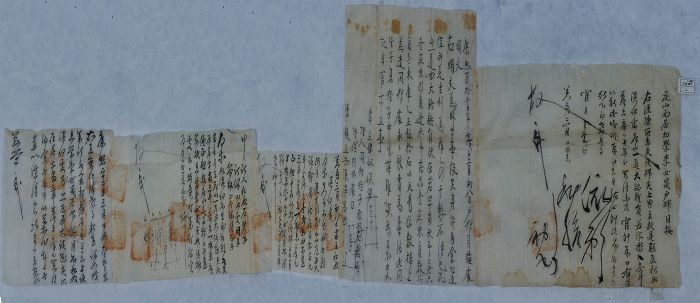 |
Title | |
| English | Estate Certificate by Haenam Prefecture | |
| Chinese | 海南尹氏 土地買賣 立案 | |
| Korean(RR) | 해남윤씨 토지매매입안(Haenam Yunssi Tojimaemae Iban) | |
| Text Details | ||
| Genre | Historical Manuscripts | |
| Type | Certificate | |
| Author(s) | Tami | |
| Year | 1683 | |
| Source | ||
| Key Concepts | bill of sale, petition, certificate, chief slave | |
| Translation Info | ||
| Translator(s) | Participants of 2018 Summer Hanmun Workshop (Advanced Translation Group) | |
| Editor(s) | Sanghoon Na | |
| Year | 2018 | |
목차
Introduction
1683년 해남현(海南縣) 입지(立旨)
1682년(肅宗8)에 私奴 淡伊가 幼學 李必晟의 戶婢 月梅에게 畓 9마지기를 放賣하면서 작성한 明文.
주제
1682년(肅宗8)에 사노 담이가 畓 3마지기를 유학 이필성의 호비 월매에게 正租 10石을 받고 팔면서 써준 明文이다. 正租는 벼를 말한다. 매매 대상인 토지는 花山一道面 大路越員에 있는 若字 畓 3마지기인데, 이는 세 배미[夜味]로 이루어진 9마지기의 일부분으로서, 東邊의 한 배미이며, 卜數로는 10卜 3束이다. 배미[夜味]는 하나의 논두렁으로 구획된 畓 한 개를 헤아릴 때 쓰는 말이다. 따라서 이는 면적의 광협과는 상관이 없는 말이다. 員은 전답이 소재하는 들판을 이른다. 이 명문의 작성에는 畓主 이외에, 證人으로는 사노 石碧이, 證人 및 保人으로는 內奴 處日이, 筆執으로는 진득창이 각각 참여하였다. 內奴는 內需司에 소속된 종이다. 이 명문에는 증인, 보인, 필집이 각각 이 매매의 내용이 진실함을 진술한 招辭가 붙어 있으며, 官에서는 이를 기초로 이듬해인 1683년(肅宗9)에 이 매매 사실을 확인해주는 立案을 발급하였다.
용어
마지기(斗落只)는 파종량을 기준으로 한 전답의 면적 단위이다. 1마지기는 한 말[斗]의 씨앗을 파종할 수 있는 면적인데, 대개 토질에 따라 그 면적의 크기에 다소 차이가 있다. 卜數는 소출량에 근거한 租稅 單位이며, 負數로도 쓴다. 1負는 타작하기 전의 볏단 한 짐의 분량이다.
Original Script
| Image | Text | Translation |
|---|---|---|
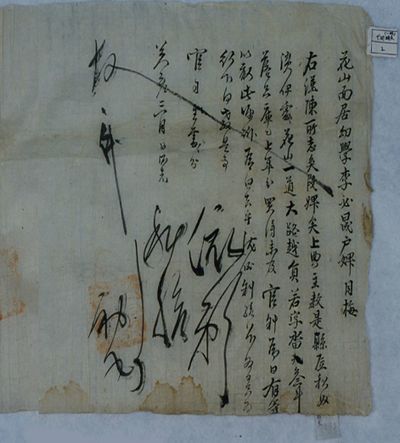
|
花山面居幼學李必晟戶婢月梅 右謹陳所志矣段婢矣上典主敎是縣居私奴 淡伊處花山一道大路越員若字畓參斗 落只庫乙上年分買得未及官斜爲白有等 以敢此呼訴爲白去乎依例斜給行下爲白只爲 行下向敎是事 官司主處分 癸亥三月 日所志 官[押] [題辭]依願斜給向事 初五 |
(translation) 花山面居幼學李必晟戶婢月梅 Wolmae, chief female slave of Yi Pilseong who is a scholar[1] residing in Hwasan-myeon,
The purpose of this petition is as follows: My master bought three durakji[2] of the yak paddy on Daerowol Plain of Hwasan ildo [-myeon] from the male slave Dami, living in the same prefecture, last year. However, the certificate has not been issued yet, therefore I humbly appeal to you. According to precedent, please grant me the certificate.
Please grant this petition.
Request for Magistrate’s Approval
Petition submitted on a certain day[3] of the third month of the year gyehae [1683]
[Government Signature]
[Official Decision] A certificate is issued according to your wish on the fifth day.
|
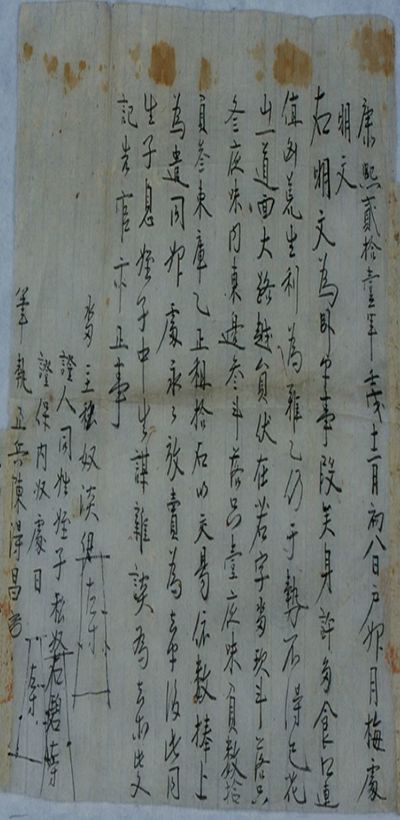
|
康熙貳拾壹年壬戌十二月初八日戶婢月梅處 明文 右明文爲臥乎事段矣身許多食口連 値㐫荒生利爲難乙仍于勢不得已花 山一道面大路越員伏在若字畓玖斗落只 參夜味內東邊參斗落只壹夜味負數拾 負參束庫乙正租拾石以交易依數捧上 爲遣同婢處永永放賣爲去乎後此同 生子息姪子中生謀雜談爲去等此 文記告官卞正事 畓主私奴淡伊[左寸] 證人同姓姪子私奴石碧[左寸] 證保內奴處日[左寸] 筆執正兵陳得昌[署押] |
(translation) III-6. 海南尹氏 土地買賣 立案[4]
The bill of sale[5] to Chief Female Slave Wolmae[6] on the 8th day of the 12th month of the 20th year [1682] of Emperor Kangxi’s reign [1661-1722]
The purpose of this bill of sale is as follows:[7] Since I [Dami] have many people in my family and encountered a series of severe famines, it is difficult to find the means to live on.[8] In this situation, I have no other choice but to exchange a strip of rice paddy for ten seok[9] of unhusked rice. The rice paddy is three durakji on the east side of three strips of paddy among nine durakji of the yak[10] paddy on Daerowol Plain of Hwasan ildo-myeon,[11] producing ten loads[12] and three bundles[13] of grain.
I take the amount [of rice] and sell the property to the female slave [Wolmae] in perpetuity. Should there be a dispute at a later date among my siblings and nephews, take this document and report to the authorities for justice in this matter.
Paddy Owner: Private Male Slave, Dami [Signature of Left Index Finger Joint]
Witness: Paternal Nephew’s Male Slave, Seokbyeok [Signature of Left Index Finger Joint]
Guarantor: Male Slave of the Palace Supply Bureau, Cheo-il [Signature of Left Index Finger Joint]
Scribe: Conscript Soldier, Jin Teukchang [Signature]
|
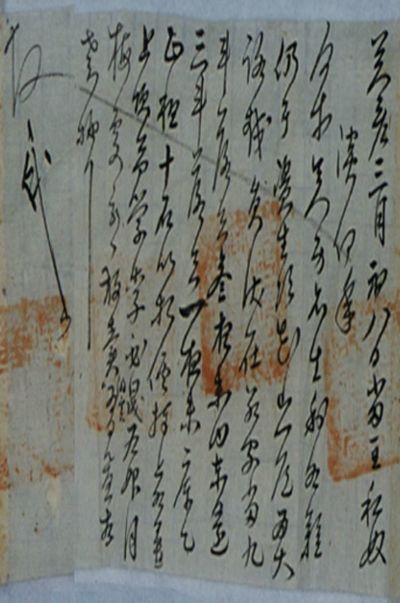
|
癸亥三月初八日畓主私奴 淡伊年 白等矣身亦生利爲難 仍于資生次花山一道面大 路越員伏在若字畓九 斗落只參夜味內東邊 三斗落只一夜味庫乙 正租十石以折價捧上爲白遣 上項幼學李必晟戶婢月 梅處永永放賣的實爲白置相 考施行 白 官[押] |
(translation) 6.3. 招辭 1 Statement of the Seller
On the eighth day of the third month of the year gyehye [1683]
I, Dami, as the paddy owner and private male slave aged ,[14] state that I had a hard time making a living and so, in order to survive, I set the price of a strip of paddy which is three durakji on the east side of three strips of paddy among nine durakji of the yak paddy on Daerowol Plain of Hwasan ildo-myeon. Ten seok of unhusked rice was the set price and I accepted the amount. It is certainly true that the property was sold in perpetuity to Wolmae, chief female slave of the above-mentioned scholar Yi Pilseong. Please consider this and certify it.
Government Office [Signature]
|
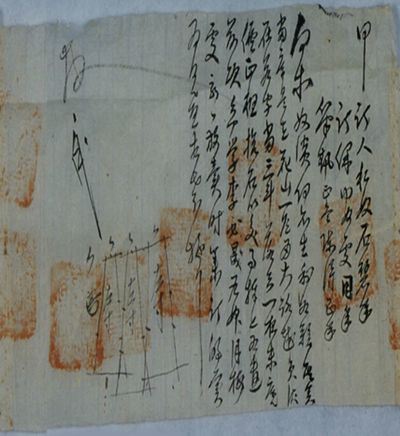
|
同日 證人私奴石碧年 證保內奴處日年 筆執正兵陳得昌年 白等奴淡伊亦生利爲難其矣 畓庫是在花山一道面大路越員伏 在若字畓三斗落只一夜味庫乙 價正租拾石以交易捧上爲遣 前項幼學李必晟戶婢月梅 處永永放賣時叅訂的實 爲白置相考施行 白[左寸] 白[左寸] 白[左寸] 白[署押] 官[押] |
(translation) 6.4. 招辭 2 Statement of the Witness, the Guarantor, and the Scribe
On the same day, Witness Seokbyeok aged ,[15] who is a private slave, Guarantor Cheo-il aged , who is a slave of the Palace Supply Bureau, and Scribe Jin Deukchang aged , who is a conscript soldier, state that Tami, a male slave, had a hard time making a living. [Thus,] he exchanged a strip of rice paddy for ten seok of unhusked rice. The rice paddy is three durakji in the yak[16] paddy on Daerowol Plain of Hwasan ildo-myeon. It is affirmed that the property was sold in perpetuity to Wolmae, chief female slave in the previously mentioned scholar Yi Pilseong’s house. Please consider this and certify it.
Witness [Signature of Left Index Finger Joint]
Witness [Signature of Left Index Finger Joint]
Witness [Signature of Left Index Finger Joint]
Witness [Signature]
Government Office [Signature]
|
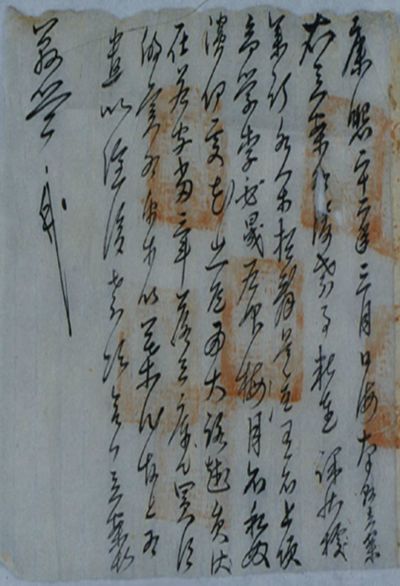
|
康熙二十二年三月日海南縣立案 右立案爲後考事粘連詳狀據 叅訂各人等招辭是置有亦上項 幼學李必晟戶婢月梅亦私奴 淡伊處花山一道面大道越員伏 在若字畓三斗落只庫乙買得 的實爲乎等以葉作官上爲 遣以憑後考次合行立案者 縣監[管押] |
(translation) 6.5. 康熙二十二年三月日海南縣立案 Certificate issued by Haenam Prefecture on a certain day of the third month of the 24th year [1684] of Emperor Kangxi’s reign [1661-1722]
This certificate is made to testify to this matter later based upon the attached documents with all the details.
Since each of the witnesses made a statement that it was certainly true for Wolmae, chief female slave of the previously mentioned scholar Yi Pilseong, to have bought three durakji of the yak paddy on Daerowol Plain of Hwasan ildo-myeon from Dami, private male slave, this official document is made. In order to be used as evidence later, the certificate should be issued.
Magistrate [of Haenam Prefecture] [Government Signature]
|
Discussion Questions
Further Readings
- 崔承熙, 『韓國古文書硏究』, 知識産業社, 1989.
- 法制處, 『古法典用語集』, 育志社, 1981.
- 檀國大學校 東洋學硏究所, 『韓國漢字語辭典』, 檀國大學校出版部, 1996.
- 장지영, 장세경, 『이두사전』, 정음사, 1983.
References
- ↑ The characters for a scholar are yuhak 幼學, which literally means a “young learner” who did not pass the civil service examination yet. JaHyun K. Haboush translates it into a “student scholar” (Haboush, The Confucian Kingship in Korea, 90) and Eugene Y. Park renders it into a “degreeless scholars.” (Park, Between Dreams and Reality, 41).
- ↑ Durakji 斗落只 or durak 斗落 (majigi in vernacular Korean) is the amount of land on which one mal (18 liters) could be planted as seed. The size of land has varied in different regions. It is approximately 150-300 pyeong (495-990 square meters) for rice paddies and 100 pyeong (330 square meters) for dry fields. See James Palais, Confucian Statecraft and Korean Institutions, (Seattle and London: University of Washington Press, 1996), 364.
- ↑ According to Sim Yeong-hwan (Senior Researcher at the Jangseogak Archives of The Academy of Korean Studies), it was usual that the exact date was not filled in because the drafter did not know when the petition would be delivered after it was completed. According to Mun Sukja (Researcher at the SNU Law Research Institute), the documents of the late Joseon period tended to omit the date unlike those of the early- or mid-Joseon period. Mun Sukja, “Reading the Documents of Property Distribution” (lecture, The Academy of Korean Studies, Seongnam, Gyeonggi province, August 22, 2018).
- ↑ An abridged certificate is called ipji 立旨, while an unabridged one is iban 立案 (estate certificate of registration). This document was made as a petition at first. Once the petition is ratified by a government office, it became a certificate. Therefore, the same document can be both a petition and a certificate.
- ↑ A bill of sale (myeongmun 明文) was given to a buyer when a deal was concluded between two individuals privately before having a government’s warrant.
- ↑ Slave Wolmae is carrying out this business for her master Yi Pilseong. The yangban literati considered it shameful to be involved in business transactions themselves during the Joseon period.
- ↑ The literal translation of this sentence would be “The bill of sale mentioned on the right is as follows.” There are two explanations on the usage of wu 右 (“right”): one is that it refers to the word “bill of sale” 明文 written vertically on the right side. The other is that it suggests the document placed in a ruler’s right side which he was supposed to deal with first. Thus, wu 右 means the present document, which is based on A Clear Distinction of Styles (Wenti mingbian 文體明辨). See Kim Seong-gap, “Joseonsidae myeongmun e gwanhan munseohakjeok yeon-gu 朝鮮時代 明文에 관한 文書學的 硏究,” (Ph.D. Diss., The Graduate School of Korean Studies, 2009), 66-7.
- ↑ This was a typical statement of contracts because it was forbidden for people to sell their inherited lands at their disposal in the Rank Land Law (gwajeonbeop 科田法). However, in the sixth year of King Sejong’s reign, it was allowed in such urgent situations as providing for the funeral and burial of their parents, repaying their outstanding debts, or escaping from the grinding poverty. See Veritable Records of King Sejong, Year 6 (1424), Month 3, Day 23, Entry 3. (available at http://esillok.history.go.kr/front/index.do). Thereafter, people usually started with plausible excuses when they wrote this kind of document.
- ↑ One seok 石 (seom in vernacular Korean) is approximately 180 liters.
- ↑ Yak 若 is the 283rd character in the Qianzi wen 千字文 (Thousand Character Classics), which is used to refer to the location of the land.
- ↑ This is located in modern Haenam in South Jeolla province.
- ↑ The character for “load” is bu 負 (“burden”) or bu 卜 (“Korean A-frame carrier”), which is the amount of crop yields that a man could carry on his back with the A-frame carrier.
- ↑ The character for “bundle” is sok 束 (“bind”), which is the amount of rice plants. A handful of rice plants are called one pa 把 (“to grasp”). Ten handfuls (pa) of rice plants make one bundle (sok).
- ↑ His age is not recorded in the original text. The space for Dami’s age is not filled in.
- ↑ His age is not recorded in the original text. The space for Seokbyeok’s age is not filled in.
- ↑ Yak 若 is the 283rd character.
Translation
- Discussion Questions:
